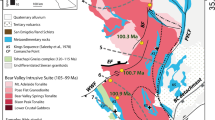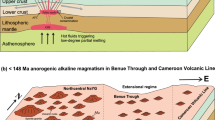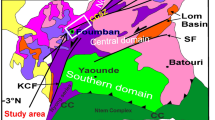Abstract
Mt. Erebus, a 3,794-meter-high active polygenetic stratovolcano, is composed of voluminous anorthoclase-phyric tephriphonolite and phonolite lavas overlying unknown volumes of poorly exposed, less differentiated lavas. The older basanite to phonotephrite lavas crop out on Fang Ridge, an eroded remnant of a proto-Erebus volcano and at other isolated locations on the flanks of the Mt. Erebus edifice. Anorthoclase feldspars in the phonolitic lavas are large (~10 cm), abundant (~30–40%) and contain numerous melt inclusions. Although excess argon is known to exist within the melt inclusions, rigorous sample preparation was used to remove the majority of the contaminant. Twenty-five sample sites were dated by the 40Ar/39Ar method (using 20 anorthoclase, 5 plagioclase and 9 groundmass concentrates) to examine the eruptive history of the volcano. Cape Barne, the oldest site, is 1,311±16 ka and represents the first of three stages of eruptive activity on the Mt. Erebus edifice. It shows a transition from sub-aqueous to sub-aerial volcanism that may mark the initiation of proto-Erebus eruptive activity. It is inferred that a further ~300 ky of basanitic/phonotephritic volcanism built a low, broad platform shield volcano. Cessation of the shield-building phase is marked by eruptions at Fang Ridge at ~1,000 ka. The termination of proto-Erebus eruptive activity is marked by the stratigraphically highest flow at Fang Ridge (758±20 ka). Younger lavas (~550–250 ka) on a modern-Erebus edifice are characterized by phonotephrites, tephriphonolites and trachytes. Plagioclase-phyric phonotephrite from coastal and flank flows yield ages between 531±38 and 368±18 ka. The initiation of anorthoclase tephriphonolite occurred in the southwest sector of the volcano at and around Turks Head (243±10 ka). A short pulse of effusive activity marked by crustal contamination occurred ~160 ka as indicated by at least two trachytic flows (157±6 and 166±10 ka). Most anorthoclase-phyric lavas, characteristic of Mt. Erebus, are less than 250 ka. All Mt. Erebus flows between about 250 and 90 ka are anorthoclase tephriphonolite in composition.








Similar content being viewed by others
References
Ancochea E, Fuster JM, Ibarrola E, Cendrero A, Coello J, Hernan F, Cantagrel JM, Jamond C (1990) Volcanic evolution of the island of Tenerife (Canary Islands) in the light of new K-Ar data. J Volcanol Geotherm Res 44:231–249
Armstrong RL (1978) K-Ar dating: Late Cenozoic McMurdo Volcanic Group and Dry Valley glacial history, Victoria Land, Antarctica. NZ J Geol Geophys 21:685–698
Cande SC, Kent DV (1992) A new geomagnetic polarity time scale for the Late Cretaceous and Cenozoic. J Geophys Res 97:13917–13951
Chester DK, Duncan AM, Guest JE, Kilburn CRJ (1985) Mount Etna, the anatomy of a volcano. Chapman and Hall, London, pp 1–404
Cooper AK, Davey FJ, Behrendt JC (1987) Seismic stratigraphy and structure of the Victoria Land basin, western Ross Sea, Antarctica. In: Cooper AK, Davey FJ (eds) The Antarctic Continental Margin: geology and geophysics of the western Ross Sea. Circum-Pacific Council for Energy and Resources, Houston, pp 27–65
Deino A, Potts R (1990) Single-crystal 40Ar/39Ar dating of the Olorgesailie Formation, Southern Kenya Rift. J Geophys Res 95:8453–8470
Dunbar NW, Kyle PR, McIntosh WC, Esser RP (1995) Tephra layers in blue ice, Allan Hills, Antarctica: a new source of glacial tephrochronological data. In: IUGG XXI General Assembly, Abstracts, p A303
Esser RP, Kyle PR, McIntosh WC (2003) Data Repository for “40Ar/39Ar dating of the eruptive history of Mount Erebus, Antarctica: volcano evolution.” New Mexico Bureau of Geology and Mineral Resources Open File Report OF-AR-20
Esser RP, McIntosh WC, Heizler MT, Kyle PR (1997) Excess argon in melt inclusions in zero-age anorthoclase feldspar from Mt. Erebus, Antarctica, as revealed by the 40Ar/39Ar method. Geochim Cosmochim Acta 61:3789–3801
Foland KA, Fleming TH, Heimann A, Elliot DH (1993) Potassium-argon dating of fine-grained basalts with massive Ar loss: application of the 40Ar/39Ar technique to plagioclase and glass from the Kirkpatrick Basalt. Antarctica Chem Geol 107:173–190
Funaki M (1983) Paleomagnetic investigation of McMurdo volcanics, Antarctica. Nankyoku Shiryo 77:1–19
Guest JE, Duncan AM, Chester DK (1988) Monte Vulture Volcano (Basilicata, Italy): an analysis of morphology and volcaniclastic facies. Bull Volcanol 50:244–257
Harpel CJ, Kyle PR, Caldwell, DA, McIntosh WC, Esser RP (2004) 40Ar/39Ar dating of the eruptive history of Mount Erebus, Antarctica: summit flows and caldera collapse. Bull Volcanol (in review)
Kyle PR (1976) Geology, mineralogy, and geochemistry of the Late Cenozoic McMurdo Volcanic Group, Victoria Land, Antarctica. Unpublished PhD Thesis, Victoria University, Wellington
Kyle PR (1977) Mineralogy and glass chemistry of recent volcanic ejecta from Mt. Erebus, Ross Island, Antarctica. NZ J Geol Geophys 20:1123–1146
Kyle PR (1981a) Mineralogy and geochemistry of a basanite to phonolite sequence at Hut Point Peninsula, Antarctica, based on core from Dry Valley Drilling Project Drillholes 1, 2 and 3. J Petrol 22:451–500
Kyle PR (1981b) Glacial history of the McMurdo Sound area as indicated by the distribution and nature of McMurdo Volcanic Group rocks. In: McGinnis LD (ed) Dry Valley Drilling Project. AGU, Washington, DC
Kyle PR (1990a) McMurdo Volcanic Group-Western Ross Embayment: introduction. In: LeMasurier W, Thomson J (eds) Volcanoes of the Antarctic Plate and Southern Oceans. Antarctic Research Series. Am Geophys Union, Washington, DC, pp 18–25
Kyle PR (1990b) Erebus Volcanic Province: Summary. In: LaMasurier W, Thomson J (eds) Volcanoes of the Antarctic Plate and Southern Oceans. Antarctic Research Series. Am Geophys Union, Washington DC, pp 81–88
Kyle PR (1990c) Melbourne volcanic province; Summary: In: LaMasurier W, Thomson J (eds) Volcanoes of the Antarctic Plate and Southern Oceans. Antarctic Research Series. Am Geophys Union, Washington DC, pp 48–52
Kyle PR (1994) Volcanological and environmental studies of Mount Erebus, Antarctica. In: Antarctic Research Series. AGU, Washington DC, p 162
Kyle PR, Cole JW (1974) Structural control of volcanism in the McMurdo Volcanic Group, Antarctica. Bull Volcanol 38:16–25
Kyle PR, Dibble RR, Giggenbach WF, Keys HJ (1982) Volcanic activity associated with the anorthoclase phonolite lava lake, Mount Erebus, Antarctica. In: Craddock C (ed) Antarctic geoscience. The University of Wisconsin Press, Madison, Wisconsin, p 1172
Kyle PR, Moore JA, Thirlwall MF (1992) Petrologic evolution of anorthoclase phonolite lavas at Mount Erebus, Ross Island, Antarctica. J Petrol 33:849–875
Le Bas MJ, Le Maitre RW, Streckeisen A, Zanetti B (1986) A chemical classification of volcanic rocks based on the total alkali silica diagram. J Petrol 27:745–750
Lo CH, Onstott TC, Chen CH, Lee T (1994) An assessment of 40Ar/39Ar dating for the whole rock volcanic samples from the Luzon Arc near Taiwan. Chem Geol 114:157–178
Macdonald GA (1965) Hawaiian calderas. Pacific science 19:320–334
Mankinen EA, Cox A (1988) Paleomagnetic investigation of some volcanic rocks from the McMurdo Volcanic Province, Antarctica. J Geophys Res 93:1599–11612
Moore JA (1986) Mineralogy, geochemistry and petrogenesis of the lavas of Mount Erebus, Antarctica. Unpublished Master’s Thesis, New Mexico Institute of Mining and Technology
Moore JA, Kyle PR (1987) Volcanic geology of Mount Erebus, Ross Island, Antarctica. In: NIPR Symposium on Antarctic Geosciences. National Institute of Polar Research, Tokyo, pp 48–65
Panter KS, McIntosh WC, Smellie JL (1994) Volcanic history of Mount Sidley, a major alkaline volcano in Marie Byrd Land, Antarctica. Bull Volcanol 56:361–376
Siebert L (1984) Large volcanic debris avalanches: characteristics of source areas, deposits, and associated eruptions. J Volcanol Geothermal Res 22:163–197
Singer BS, Pringle MS (1996) Age and duration of the Matuyama-Brunhes geomagnetic polarity reversal from 40Ar/39Ar incremental heating analyses of lavas. Earth Planet Sci Lett 139:47–61
Steiger RH, Jager E (1977) Subcommission on geochronology: convention on the use of decay constants in geo- and cosmochronology. Earth Planet Sci Lett 36:359–362
Taylor JR (1982) An introduction to error analysis: the study of uncertainties in physical measurements. Univ Sci Books, Mill Valley, Calif., p 270
Treves SB (1968) Volcanic rocks of the Ross Island area. Antarctica J US 3:108–109
van den Bogaard P (1995) 40Ar/39Ar ages of sanidine phenocrysts from Laacher See Tephra (12900 yr b.p.): chronostratigraphic and petrologic significance. Earth Planet Sci Lett 133:163–174
Wadge G (1980) Output rate of magma from active central volcanoes. Nature 288:253–255
Wadge G (1982) Steady state volcanism; evidence from eruption histories of polygenetic volcanoes. JGR J Geophys Res B 87:4035–4049
Walker GPL (1988) Three Hawaiian calderas: an origin through loading by shallow intrusions? J Geophys Res 93:14773–14784
Acknowledgements
This work was supported by grants from the Office of Polar Programs, National Science Foundation. Additional funding came from within the NMGRL at the New Mexico Bureau of Geology and Mineral Resources. The authors would like to thank Nelia Dunbar for her discussions on magma chemistry and melt inclusion properties. Additional thanks goes to NSF, the Antarctic Support Associates and the US Navy VXE-6 squadron who provided the necessary field support. Improvements in the manuscript resulted from reviews by J. Kelly Russell and Andrew Calvert.
Author information
Authors and Affiliations
Corresponding author
Additional information
Editorial responsibility: J. Donelly-Nolan
Rights and permissions
About this article
Cite this article
Esser, R.P., Kyle, P.R. & McIntosh, W.C. 40Ar/39Ar dating of the eruptive history of Mount Erebus, Antarctica: volcano evolution. Bull Volcanol 66, 671–686 (2004). https://doi.org/10.1007/s00445-004-0354-x
Received:
Accepted:
Published:
Issue Date:
DOI: https://doi.org/10.1007/s00445-004-0354-x




